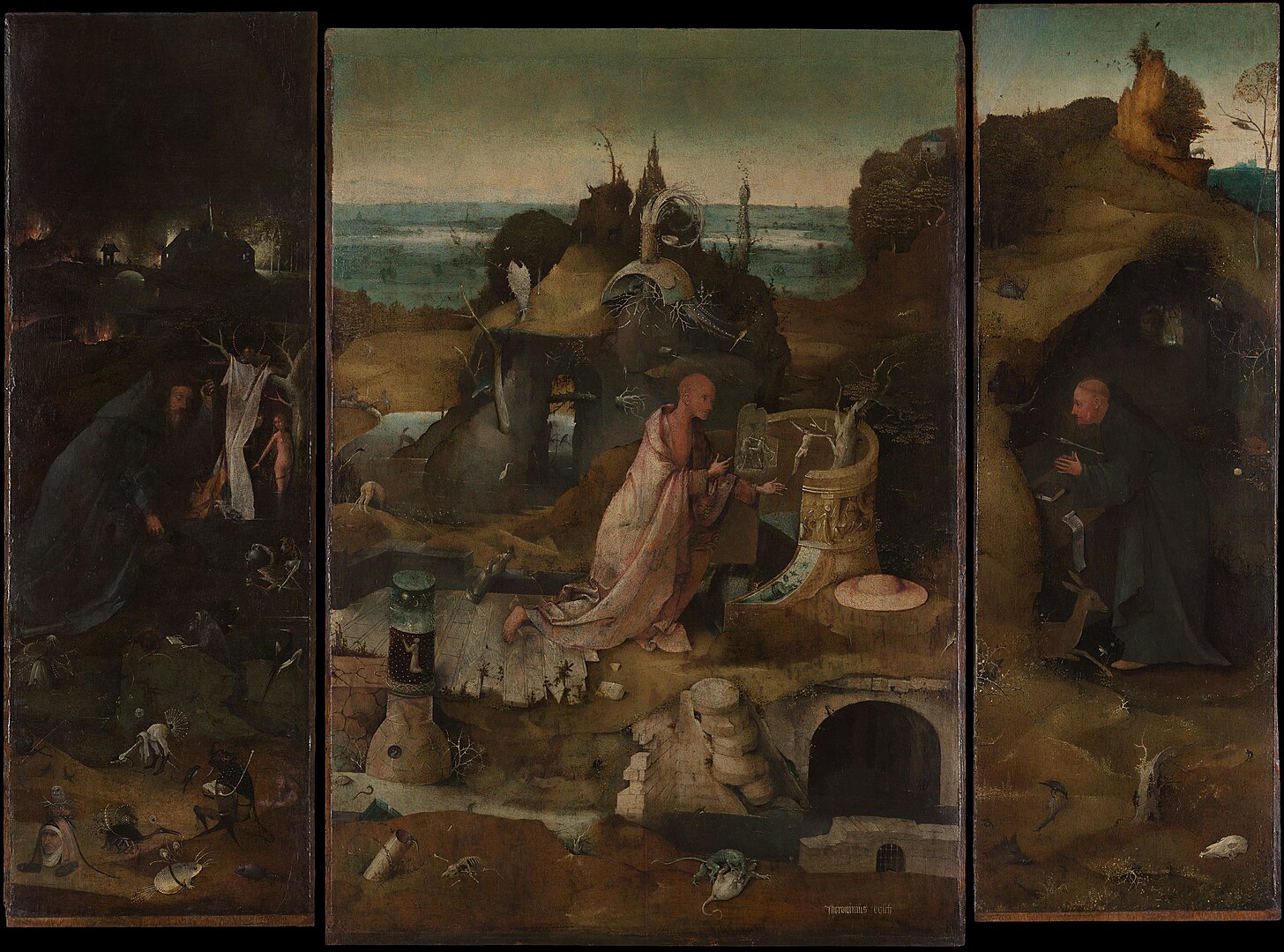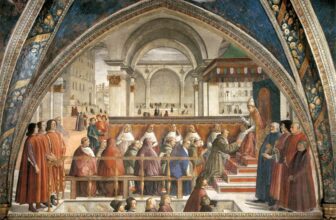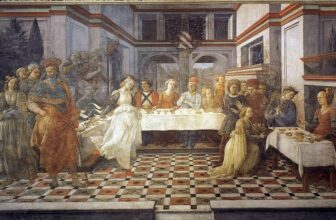
Meaning of Hermit Saints Triptych Painting
Hieronymus Bosch, the enigmatic Dutch painter of the Northern Renaissance, is renowned for his surreal, deeply symbolic, and often unsettling paintings that depict visions of morality, sin, and redemption. Among his many masterpieces, one that stands out both for its enigmatic nature and spiritual depth is the “Hermit Saints Triptych”, painted around 1493–1497. Currently housed in the Gallerie dell’Accademia in Venice, Italy, this triptych may appear subdued compared to Bosch’s more apocalyptic works like The Garden of Earthly Delights, but its richness lies in the psychological depth and religious symbolism woven into each panel.
This triptych reflects Bosch’s preoccupation with the human soul’s struggle between piety and temptation. The three saints featured , Saint Jerome, Saint Anthony Abbot, and Saint Giles , are shown in isolation, contending with their own demons, both literal and metaphorical. The work is both a reflection of personal spiritual struggle and a window into Bosch’s unique worldview , one steeped in late medieval mysticism, religious orthodoxy, and a profoundly allegorical imagination.
The Creation of the Hermit Saints Triptych
Who Painted It and How
Hieronymus Bosch (c. 1450–1516), born Jheronimus van Aken in the town of ’s-Hertogenbosch in the Duchy of Brabant (modern-day Netherlands), was part of a family of painters and developed a distinctive style that diverged radically from the serene realism of his contemporaries. His paintings are dreamlike and densely symbolic, blending religious imagery with grotesque fantasy.
The Hermit Saints Triptych was created with oil paint on panel , the preferred medium of Northern Renaissance artists, allowing for intricate detail, layered glazing, and precise symbolism. Bosch’s painting technique included underdrawings in black ink or chalk, which can still be detected via infrared reflectography, revealing preliminary designs beneath the final layers. This allowed him to adjust and refine his complex, often chaotic imagery as he worked.
It is likely that Bosch painted the triptych with the help of assistants in his workshop, particularly in areas with less detailed background work. However, the central figures and the primary symbolic elements display the master’s own hand. The triptych was probably commissioned by a private patron for devotion, which was common during the period, especially among the elite who could afford such works.
What is the Hermit Saints Triptych About?
At its core, the Hermit Saints Triptych is about spiritual contemplation, temptation, and the loneliness of saintly devotion. Each of the three panels features a different Christian hermit-saint in a desolate landscape, enduring the trials of solitude and the assaults of evil.
Left Panel: Saint Jerome
Saint Jerome is depicted kneeling before a crucifix, gazing upon the suffering of Christ while surrounded by skulls, a lion, and a ruined temple. Jerome, best known for translating the Bible into Latin (the Vulgate), is often associated with scholarly solitude and penitence. Bosch’s version, however, is filled with haunting symbols , crumbling architecture and dark shadows suggest decay, both physical and spiritual.
The lion beside him (a symbol of his legend in which he tames a lion by removing a thorn from its paw) represents the taming of the inner beast. Skulls emphasize mortality, a memento mori urging viewers to consider the fate of the soul. The ruined classical building in the background might symbolize the fallen state of paganism or worldly knowledge in contrast to divine truth.
Central Panel: Saint Anthony Abbot
The central figure of the triptych is Saint Anthony Abbot, arguably the most frequently depicted hermit in Bosch’s oeuvre. Known for the extreme temptations he endured in the Egyptian desert, Anthony is shown kneeling in contemplation despite being surrounded by bizarre, demonic creatures , hallmarks of Bosch’s style.
This panel is perhaps the most visually striking, filled with grotesque beings: monstrous birds, half-human hybrids, and floating structures in a barren, alien terrain. Saint Anthony, however, remains calm, his eyes turned upward in divine focus, symbolizing steadfast faith amidst chaos. This imagery directly alludes to the Vita Antonii by Athanasius of Alexandria, which recounts the saint’s battles with demons.
Bosch uses this visual turmoil to embody the inner psychological warfare of the pious , a world where demons may not be external enemies but internal temptations, doubts, and fears. The presence of water in the background may symbolize baptism and spiritual purification, offering contrast to the infernal foreground.
Right Panel: Saint Giles
The right panel shows Saint Giles, another hermit saint, kneeling in a forested setting. An arrow pierces his leg , referencing the legend in which he was accidentally wounded by a hunter’s arrow intended for a deer he was protecting. The saint appears in deep prayer, flanked by Gothic trees and natural overgrowth.
Giles is the patron saint of cripples, beggars, and hermits. The scene around him is calmer, yet the symbolism remains potent. The dense forest around him suggests the isolation of spiritual devotion. A deer, representing innocence and divine protection, rests beside him. His wound is a literal reminder of the pain that often accompanies selfless sacrifice.
Symbolism and Meaning
Bosch’s work operates on multiple symbolic levels , theological, psychological, moral, and even eschatological. The Hermit Saints Triptych contains a blend of Christian iconography, folkloric allegory, and Bosch’s unique symbolism, which often resists simple interpretation.
Landscape as Spiritual Terrain
Each saint is placed within a desolate or corrupted natural landscape. Nature here is not Edenic, but rather twisted, barren, or decaying , a metaphor for a fallen world. These backdrops represent the spiritual wilderness that the hermits must traverse alone, echoing the desert temptations of Christ or the wilderness trials of the prophets.
Demons and Grotesques
Bosch populates especially the central panel with his signature grotesques , bizarre hybrids that blur the line between human, animal, and machine. These creatures symbolize the temptations of the flesh, the distractions of the world, and the distortions of the mind. The surreal forms are not simply imaginative flourishes but theological statements: sin deforms, tempts, and distorts.
Ruins and Decay
The ruined buildings, broken columns, and cracked earth across the panels signify the collapse of worldly order, often contrasted with the enduring solidity of spiritual truths. Classical ruins, in particular, may critique secular knowledge or pride, advocating humility and penitence.
Light and Shadow
Bosch uses light not merely to illuminate but to symbolize divine presence. Light is sparse, breaking through clouds or filtering into shadows, hinting at moments of divine revelation or grace. The overall palette is subdued and cold, with muted browns, greys, and greens , reinforcing the theme of isolation and introspection.
What is Happening in the Painting? A Narrative Analysis
Though each panel can stand alone, together they form a triptych narrative of the solitary Christian path, from intellectual penitence (Jerome), through spiritual battle (Anthony), to wounded yet serene prayer (Giles).
Saint Jerome begins the journey, symbolizing mental devotion and penitence. He is turned inward, contemplating Christ’s sacrifice, distanced from the chaos of the world.
Saint Anthony Abbot represents the heart of the struggle, besieged by inner demons, yet undistracted in prayer. He is the spiritual warrior.
Saint Giles, though wounded, is the image of spiritual serenity , his prayer uninterrupted, his wound a symbol of martyr-like compassion.
Bosch doesn’t show literal action or dramatic movement. Instead, the drama is psychological and spiritual, making the viewer reflect on their own trials and faith.
What Kind of Art is This?
Style and Period
The Hermit Saints Triptych is a work of Northern Renaissance art, infused with elements of Gothic mysticism and proto-Surrealism. Bosch is often classified as a proto-Surrealist, though his work long predates that movement. The classification comes from his imaginative visions, abstract forms, and dreamlike spaces that challenge linear perspective and realism.
The painting also aligns with devotional art, intended not for public display but for private spiritual meditation. The triptych form itself was common for altarpieces and devotional panels in the 15th century.
Techniques and Aesthetic
Oil on panel allows for precise detailing, subtle glazes, and textural contrast.
Bosch’s microscopic attention to detail , visible in the rendering of bark, feathers, or demon faces , invites slow, meditative viewing.
The color palette is subdued but purposeful: earthy tones dominate, echoing the themes of mortality, withdrawal, and introspection.
Current Location and Legacy of Hermit Saints Triptych Painting
Today, the Hermit Saints Triptych resides in the Gallerie dell’Accademia in Venice, where it remains one of Bosch’s most contemplative and spiritually intense works. It was likely brought to Italy during the Renaissance, a time when Northern European art began to influence Italian collectors and patrons.
The triptych has inspired centuries of art historians, theologians, psychoanalysts, and modern artists. Its influence is seen in surrealist painting, literature, and even cinema. Bosch’s unique ability to blend theological instruction with fantastical invention makes this work a profound artifact of medieval spiritual psychology.
Hieronymus Bosch’s Hermit Saints Triptych is more than a religious painting; it is a spiritual mirror. Through Jerome’s penitence, Anthony’s trials, and Giles’s serene suffering, Bosch explores the full arc of the Christian hermit’s soul , from intellectual contemplation to existential battle to wounded grace. The triptych’s layered symbolism, haunting beauty, and surreal strangeness invite us into an intense meditation on faith, temptation, and redemption.
For modern viewers, it offers both a glimpse into the late medieval mindset and a timeless reflection on the inner life , still relevant in an age where the battle between the sacred and the profane continues, often within the silence of our own hearts.




